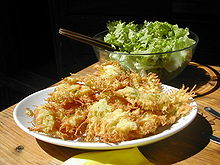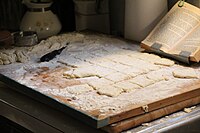food.wikisort.org - Dish
Beignet (/ˈbɛnjeɪ/ BEN-yay, also US: /beɪnˈjeɪ, bɛnˈjeɪ/ bayn-YAY, ben-YAY,[1][2][3][4] French: [bɛɲɛ]; lit. 'bump') is a type of fritter, or deep-fried pastry, usually made from yeast dough in France, possibly made from pâte à choux and called Pets-de-nonne, nun's fart, in France, but may also be made from other types of dough, including yeast dough.[5] In France there are many different versions of them, at least 20 and they can vary in shape, flour used for the dough, and filling. It is popular in French, Italian and French-American cuisines.
 Potato beignets from Haute-Savoie | |
| Type | Pastry |
|---|---|
| Place of origin | Ancient Rome |
| Main ingredients | Dough, powdered sugar |
| Variations | Sourdough |
Types
This section needs additional citations for verification. (June 2021) |
The term beignet can be applied to two varieties, depending on the type of pastry. The French-style beignet in the United States has the specific meaning of deep-fried choux pastry.[5]
Beignets can also be made with yeast pastry,[6] which might be called boules de Berlin in French, referring to Berliner doughnuts, which lack the typical doughnut hole, filled with fruit or jam.
In Corsica, beignets made with chestnut flour (beignets de farine de châtaigne) are known as fritelli.
In Canadian French, doughnuts are referred to alternately as beigne or beignet.
Louisiana

Louisiana-style beignets are square or rectangular fried pastries made from leavened dough rather than choux pastry. In New Orleans, they are best known as a breakfast served with powdered sugar on top.[5] They are traditionally prepared right before consumption to be eaten fresh and hot. Variations of fried dough can be found across cuisines internationally; however, the origin of the term beignet is specifically French. In the United States, beignets have been popular within New Orleans Creole cuisine and may also be served as a dessert. They were brought to New Orleans in the 18th century by French colonists,[6] from "the old mother country",[7] also brought by Acadians,[8] and became a large part of home-style Creole cooking. Variations often including banana or plantain – popular fruits in the port city – or berries.[9][10]
Preparation
Ingredients used to prepare beignets traditionally include:
- lukewarm water
- granulated sugar
- evaporated milk
- bread flour
- shortening
- oil or lard, for deep-frying
- confectioners' sugar
- Beignets before frying
- Piping choux pastry dough for beignets
See also
- List of choux pastry dishes
- List of doughnut varieties
- Churro – Fried-dough pastry
- Cuisine of New Orleans – Culinary traditions of New Orleans, Louisiana, US
- Lokma – Deep fried dough pastries
- Mekitsa – Dish made of kneaded deep fried dough made with yogurt
- Lángos – Hungarian deep-fried flatbread
- Puff-puff – African fried dough snack
- Sufganiyah – Round jelly-filled doughnut served at Hanukkah
- Zeppole – Italian pastry
References
- "beignet". The American Heritage Dictionary of the English Language (5th ed.). HarperCollins. Retrieved 18 May 2019.
- "Beignet". Collins English Dictionary. HarperCollins. Retrieved 18 May 2019.
- "beignet"[dead link] (US) and "beignet". Lexico UK English Dictionary. Oxford University Press. Archived from the original on 2020-03-22.
- "beignet". Merriam-Webster Dictionary. Retrieved 18 May 2019.
- Davidson, Alan (1999). Oxford Companion to Food. Oxford University Press. p. 70. ISBN 9780192115799.
- "Beignet History and Recipe". WhatsCookingAmerica.net. 21 April 2015. Archived from the original on November 9, 2016. Retrieved February 13, 2017.
- Schneider, Wendi (1989). The Picayune's Creole Cook Book. New York: Random House. p. 385.
- "Beignets". cafedumonde.com. Café du Monde. Archived from the original on August 24, 2018.
- McKnight, Laura (November 16, 2007). "Beignets: More than Just a Doughnut". houmatoday.com.
- "Of Interest to Women: Banana Served In Appetizing Forms". The Philadelphia Inquirer. January 1, 1907.
Further reading
- Yves Thuriès, French Pastry, ISBN 0-471-28598-6
- Rosana G. Moreira et al., Deep Fat Frying: Fundamentals and Applications, ISBN 0-8342-1321-4
External links
 Media related to Beignets at Wikimedia Commons
Media related to Beignets at Wikimedia Commons
На других языках
- [en] Beignet
[ru] Бенье
Бенье́ (фр. beignet, от фр. beigne — «пощёчина»[1]) — французское название блюд, приготавливаемых обжариванием во фритюре различных продуктов, предварительно окунаемых в кляр, преимущественно фруктов и овощей. Бенье без начинки — пончики. В американской кухне похожие блюда носят название «фриттеры», и на английском бенье называются «французские фриттеры»[2]. Яблочное бенье «апфелькюхле» — традиционный десерт на юге Германии.Другой контент может иметь иную лицензию. Перед использованием материалов сайта WikiSort.org внимательно изучите правила лицензирования конкретных элементов наполнения сайта.
WikiSort.org - проект по пересортировке и дополнению контента Википедии


